Everyone knows in theory that the fresher the vegetables, the better they are. But I think that many of us fall into the habit of buying a bit too many vegetables, storing them in the fridge, and using them as long as they haven't rotted away or become science experiments in some form. You know, things like carrots and celery, apples and other rather indestructible produce.
But once you see how produce does deteriorate, you start to wonder. Case in point I had some rhubarb stalks left over, and stored in the fridge for about a week after I bought them. (Normally I cook rhubarb right away, but it was cheap at the market so we'd bought more than we needed.) So, yesterday I took them out - they looked crisp and perfectly fine - and turned them into rhubarb crumble pie.
Filed under:
fruit vegetables produce
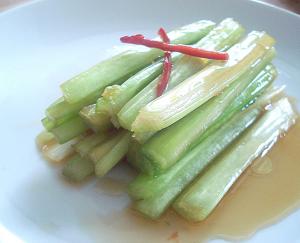
Celery isn't a very Japanese vegetable, but with the addition of the right flavors it can be turned into a refreshingly crunchy pickle that goes well with white rice, which is the base criteria for determining whether a pickle fits a Japanese meal or not. Besides, I always seem to have some celery in my fridge (who doesn't?), and this is a good excuse to use some up.
This is a nice salad-like pickle, that's best eaten with some of the pickling liquid spooned like dressing over the top. There's a nice bite and a color zing from the thin slivers of red chili pepper. (Pirikara means spicy-hot.) There's a little sake and mirin in the dressing, which gives it a twist.
Since celery is more fibrous than cucumber, it needs to marinade for a bit longer. Give it at least 3 hours, or overnight. It doesn't keep too well at room temperature, so reserve this for eating at home. It assembles as quickly as the other quick pickles in this series.
Filed under:
japanese lighter vegetables vegetarian vegan salad tsukemono
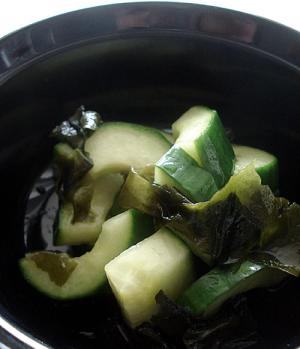
This Japanese sokusekizuke method of letting vegetables marinate in a vinegar-based marinade is similar to Western pickling methods, but there's no canning and sterilation and things involved since these are meant to be eaten within a couple of days like all quick pickles. The vinegar marinade is simply meant to enhance the flavors of the vegetables rather than preserve it for long keeping.
These cucumber pickles are sweet, sour and a bit salty all at the same time. The flavor is quite mild and fresh, so I can eat these several days in a row and not get tired of them. The wakame seaweed can be left out if you prefer, but makes a nice contrast to the cucumber while adding its own umami to the marinade.
The pickles can be eaten anytime from a couple of hours after putting them in the marinade to about 3 days later or so, if you keep it in an airtight container in the refrigerator.
Filed under:
japanese vegetables salad tsukemono
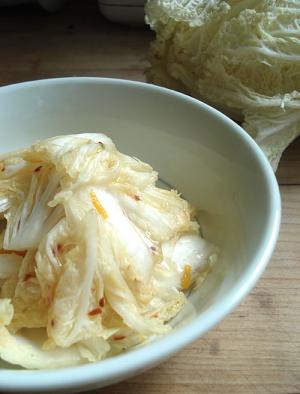
This has to be one of the easiest and tastiest ways of preparing Chinese or napa cabbage (hakusai) that I know of. All you taste is the fresh essence of the cabbage, with the heat of the red pepper and the slight twist of the orange zest.
Did I say easy? Wash and chop up the leaves, mix together the flavoring ingredients, dump all in a plastic bag, shake then massage. That's it. It's ready to eat right away, though the flavors to meld a bit better if you can manage to keep it in the fridge for at least an hour before eating.
I've used ingredients that anyone should have, even if you aren't stocked up on typical Japanese ingredients. Adjust the amount of red pepper flakes up or down to your taste.
Filed under:
japanese lighter vegetables vegetarian quickcook bento vegan under10 tsukemono
In Japan, tsukemono or pickles are used as hashi-yasume, literally "chopstick resters", side dishes that have a totally different texture and flavor. So for instance if you had some grilled meat with a sweet-savory sauce as the main course, you might have some simple, crunchy pickled cucumber slices to go with it.
This week I'll be posting some quick Japanese vegetable pickle recipes. Japanese pickles can be very loosely divided into three kinds: the kind that take some time to 'ripen', but then last indefinitely, rather like Western style pickles; the kind that is ready in a few days, but which require a pickling bed that takes time to make and to maintain; and finally, the quick and easy kind that can be made and eaten within a day. The last two kinds do not keep well - just like fresh vegetables, they must be eaten within a short time.
Quick pickles, called sokusekizuke (instant pickles) or ichiya-zuke (overnight pickles) depending on how long they take to come to full flavor, are very easy to make as their names suggest. They are a great way to prepare vegetables without having to add any additional fat, though a few recipes do call for some oil.
Filed under:
japanese lighter preserves and pickles vegetables vegan salad tsukemono
I am going to take the weekend off from the computer because I have a Mountain Of Things to Do away from it. Next week, I'll have a series of posts about quick Japanese pickles, or sokuseki zuke. Sokuseki zuke pickles are the busy cook's alternative to 'real' pickles like nukazuke (rice brain pickles), of the kind that require nursing a pickling bed, long resting periods, and such complicated procedures. The word sokuseki means instant, and these pickles are usually ready to eat in a short period, anywhere from overnight to about an hour.
Filed under:
japanese preserves and pickles vegetables
Submitted by maki on 14 March, 2007 - 14:51
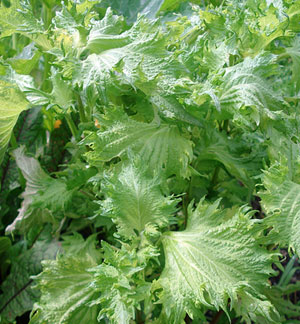
I am finally getting around to sowing some seeds for the vegetable garden. I really should have sown some things earlier, but I figure it's not too late yet.
If you are planning a vegetable garden, or even a few pots on your windowsill, and want to introduce some Japanese flavors, here's a list of some herbs and vegetables to consider growing, in order of importance and ease of growing in a temperate climate. (That's one with real winters...at least, before global warming.) The ones marked with an *asterisk can be grown in pots. A couple of my favorite seed sources are listed at the bottom.
Type:
feature Filed under:
japanese vegetables shopping gardening herbs
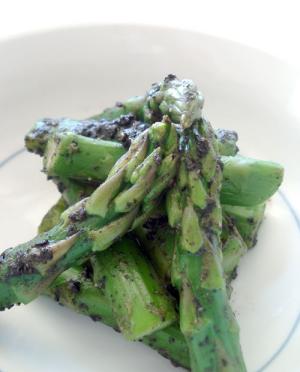
We're starting to see asparagus at reasonable prices again in the stores, which I'm really happy about. The ones available now come from California and Mexico, so they aren't very food-miles-correct, but I still can't resist buying a bunch or two. In a few weeks we'll start seeing asparagus from a a bit closer places like Spain and France, not to mention fat white asparagus from Germany.
This is aspagarus with a ground sesame sauce, which would be called aemono (as explained in the broccoli ae recipe) if made with white sesame seeds, but since this version is made with black sesame seeds it's called gomayogoshi, or "dirtied with sesame". I don't think it looks dirty - I really like the contrast of the bright green asparagus with the black sesame sauce. You can, of course, use regular white (brown) sesame seeds instead, in which case it would be called asparagasu no goma ae. The sweet nutty sauce compliments the asparagus quite well.
I've included step by step instructions for grinding sesame seeds in a suribachi. You can grind up the sesame seeds in a plain mortar and pestle instead. You may be able to buy pre-ground sesame (surigoma), though that isn't nearly as fragrant as freshly ground sesame.
It makes a great side dish, as well as being great for your bento box.
Filed under:
japanese lighter vegetables vegetarian bento vegan gluten-free
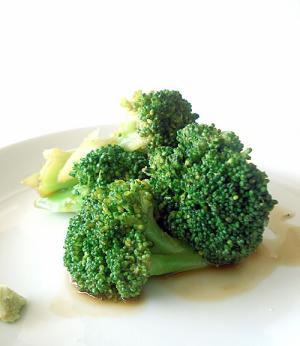
All hail the mighty broccoli. While it's always available in the produce section, it's one of the few fresh vegetables that haven't been shipped halfway around the world to reach people who live in many parts of the northern hemisphere during the colder months. In the spring we even get very locally grown broccoli and its relatives like romanesco.
Broccoli can be rather boring if it's just served steamed, boiled or, god forbid , raw. (I'm sorry, I don't really get raw broccoli. Raw cauliflower yes, but not raw broccoli.) A way to perk up broccoli without relying on those yummy yet caloric additions like mayonnaise, cheese sauce or garlic-and-olive-oil, is to make aemono or ohitashi with them. Ohitashi is basically vegetables that have been steamed or blanched/boiled served with a sauce that contains soy sauce, often but not always a little dashi stock, and sometimes a bit of sake or mirin and sugar. Aemono uses a similar sauce, with added ingredients like ground up sesame seeds. In this recipe, the sauce contains wasabi, so it's aemono.
As long as you have all the ingredients on hand it's very quick to make, and very tasty. The sinus-clearing qualities of the wasabi are softened by the other ingredients in the sauce, while still giving the broccoli a nice, bright flavor.
It makes a great side dish as part of a Japanese meal, or even a salad. It's also a very nice bento item (you may want to contain the sauce in a paper cup or its own container).
Filed under:
japanese lighter vegetables vegetarian quickcook bento vegan under10 gluten-free
February is not really a great month for local fresh produce around here, but there is one category of vegetables that is quite abundant around this time - greens. There's endive, kale, spinach, Swiss chard, chicory, and some less common greens like puntarelle. One problem with many winter or early-spring greens is that they have a bitter flavor.
There are various ways of reducing or counteracting the bitterness; the method you use depends on the kind of greens you are using and how concerned you are about retaining nutrients and such.
Filed under:
vegetables produce
Pages